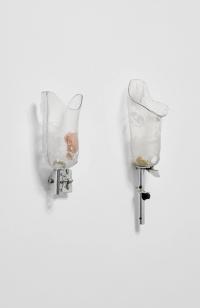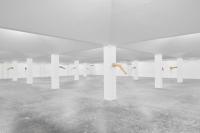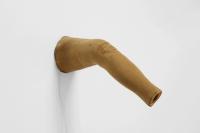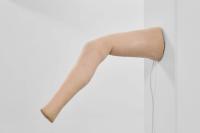Works




Installation Views
Press Release
Disability, as anthropogenesis, allows us to reflect upon a humanity that has to be learned, rather than being granted at birth. Man is born without knowing how to speak, write, eat or walk; unless being taught, he is incapable of surviving without the civilising cares of culture. Hence, technique is presented as the mastery of the relationship between nature and humanity; if a man is tossed by nature into life without survival abilities, technique allows him to produce himself.
Through discipline, how to learn to manipulate the body is rationalised, and how to perform control exercises on oneself that standardise the most common activities, even the strictest moral and ethical codes, through a normative imposition. This is how, under the guardianship of a relatively outdated thinking model, one of the distinctions of what is human is expressed with an anatomical behavior: walking upright. The operations to discipline the body (in which a human can be determined as one) have kept verticality as their axis. The training of the body is a mechanism of coercions and “discipline is a political anatomy of detail”1. If anthropotechniques are the sets of actions or exercises–-both symbolical and formal–-that allow humans to recognise themselves as such, it is because we are beings of technique, because we turn the things we produce into our condition. In this sense, walking upright is a technology, a logos of the technē, a know-how, a practical knowledge to discipline the body.
Prostheses are technical devices, but they also precede that condition; prostheses are linguistic. If we take our distance from the medical sense of a prosthesis, that is to say, of the addition or replacement of a missing body part for an artificial one, a prosthesis would not be a simple extension of the human body, but the human condition itself, its constitution. Therefore, there is no human nature; facing nature, the human is entirely prosthetic.
If human beings are disabled beings, who has the capacity to represent normality?
It would seem easy and not so risky to question disability from the comfort of a body with no motor limitations, amputations or congenital anomalies, yet disability is not limited to the phenomena occurring in the body; disability is political. Women in this sense, have not been exempt from being historically disabled due to the hierarchical phallogocentrist construction (verticality par excellence).
It may be supposed that part of politics is about the handicapped, that from the perspective of an “existentialism of resistance or obstinacy”, there is an obligation to overcome obstacles, to survive regardless. The political implications in relationship to the foundational incapacities make the acquired disabilities raise the controversy of “whether all political culture does not begin with the distinction between chains and crutches”2. Social class is involved in the political dimension of prosthetics and orthotics3 in Mexico. In this country, private medical insurance is not only practically inaccessible for most of the population, but also access to basic services -– from food to health-– are scarce. Malnutrition during pregnancy can cause future deficiencies or syndromes for the product and it also must be considered that in the most violent and precarious areas the risk of not only losing a body part but life itself rises exponentially. People with disabilities derived from an amputation or the lack of a limb can hardly conceive of receiving a replacement for a high technology and sophisticated device. In Mexico, prosthetics and orthotics are precarious and it is also of importance that disability cases are proportional to the marginalisation index. Thus, it is more than symbolic to try to teach a human how to walk in a country where the population is constantly falling into pieces.
Orthotics and prosthetics are not vestiges of the foreign disease, but political projections of the body, they are processes, actions or states of existence. They not only suggest -–based on the conditions of physical decadence of the human–when can a body be considered useless or irreparable? But, with the fragility at stake, the identity and processes that give a body order are disrupted and the capacity of objects or technical devices for political action is debated.
Furthermore, when prosthetics are only physical, when the materiality connected to the use- purpose is not surpassed, prosthetics or orthotics may fall into a reductionism and merely become cultural tools of normalisation with a compulsive spotlight on corporal norms and, rather than threatening the sphere of normality, they reaffirm it. First, physiognomically, they have to perform how a normal-looking body should. Secondly, the purpose is determined by its usefulness and productivity for economic systems.
If the shape of the human being is determined by the logic of its functionality and productivity in relation to work, and if work was the only essential action of the human being, what happens with the disabilities that escape efficiency and effectiveness in production? Perhaps the act of man producing himself is a form of exercise. Perhaps they are ways of doing and producing his own existence, beyond the work that is defined by a salary, and it is more about deciphering himself in everyday life.
If persons with disabilities are perceived in the social imaginary as cripples that produce pity, then that is because being human is not considered to be a constant training that must be exercised. A being that struggles with itself to go beyond its shape should not cause any pity. The tendency to pathologise the body based on the yearning for normality is a deliberate exclusion of other possibilities of the human experience. Correcting is not merely correcting nature, but suppressing difference. If existence has always required orthopedics and prosthetics, how do we embody and think the non-normative? How can we avoid being under public scrutiny, having to do normal things through hard exercise? How can we zigzag “the paradox of a normality for the non-normal”4?
If human beings are prosthetic beings, then that is because they are the artifacts of themselves. As such they have the ability to technically intervene in their own nature by producing prosthetics that allow them to enunciate and constitute themselves transversally between corporeal limits, to create possibilites that allow to think about themselves more as living beings, rather than human beings.
Berenice Olmedo
1 Foucault, Michel, Discipline & Punish. The Birth of the Prison, New York, Vintage Books, 1995, p. 139. 2 Sloterdijk, Peter, You Must Change Your Life. On Anthropotechnics, Malden, MA, Polity Press, 2013, p. 57. 3 An orthosis is “an externally applied device used to modify the structural and functional characteristics of the neuromuscular and skeletal system”, https://en.wikipedia.org/wiki/ Orthotics. 4 Sloterdijk, Peter, You Must Change Your Life. On Anthropotechnics, Malden, MA, Polity Press, 2013, p. 44.












